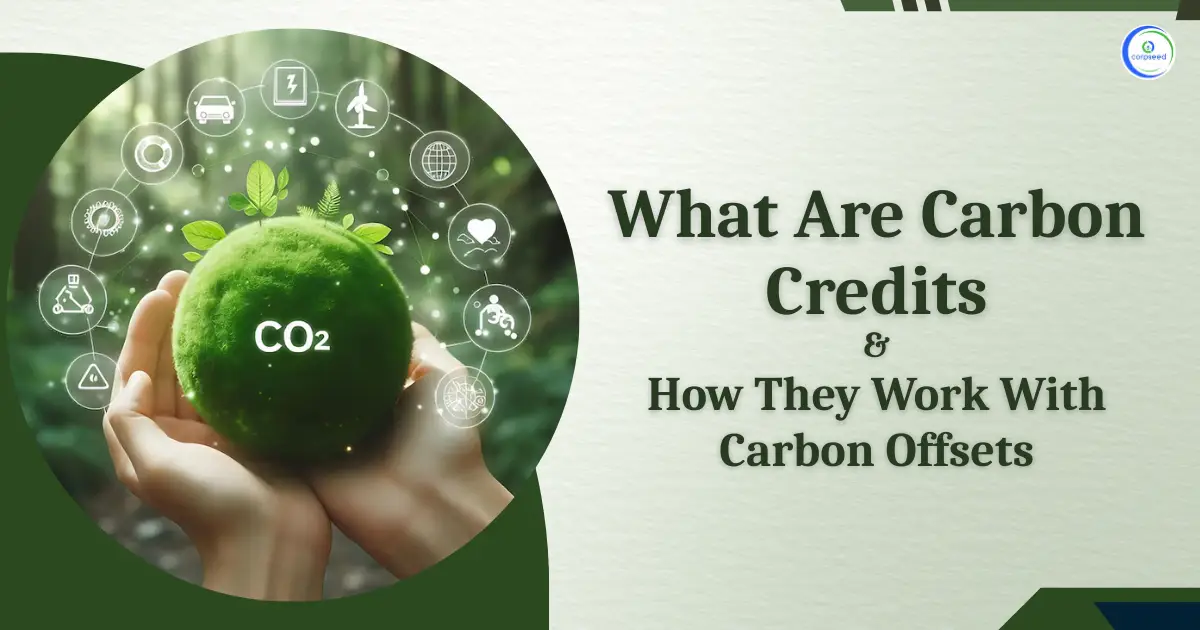A carbon footprint is a key measure of environmental responsibility, reflecting the total greenhouse gas (GHG) emissions produced by human activities. In 2025, the importance of understanding and reducing carbon footprints has increased dramatically due to climate change concerns, stricter environmental regulations, and growing consumer awareness.
In simple terms, a carbon footprint is the total amount of greenhouse gases - mainly carbon dioxide (CO₂), methane (CH₄), and nitrous oxide (N₂O) - emitted directly or indirectly by individuals, organizations, products, or activities, expressed in carbon dioxide equivalent (CO₂e). These emissions result from transportation, electricity use, industrial operations, agriculture, and waste management.
Monitoring and reducing carbon footprints is not just an environmental obligation; it also provides social, economic, and regulatory advantages, particularly in India, where rapid urbanization and industrial growth have significantly increased GHG emissions.
Table of Contents
- What Is a Carbon Footprint?
- Why Carbon Footprint Matters in 2025?
- Key Contributors to Carbon Footprint in India
- Global Carbon Footprint Trends in 2025
- 7 Effective Ways to Reduce Carbon Footprint
- Role of Businesses in Carbon Footprint Reduction
- Government Policies Supporting Carbon Footprint Reduction in India
- Conclusion
--------------Blog Contact Form-------------
What Is a Carbon Footprint?
A carbon footprint measures the total greenhouse gas emissions caused by an activity, product, or entity over its lifecycle. While carbon dioxide is the most common GHG, methane and nitrous oxide are more potent in terms of warming potential. Using CO₂e allows for standardized comparison of different gases’ impact on the climate.
Types of Carbon Emissions
The Greenhouse Gas Protocol classifies emissions into three categories:
- Scope 1 (Direct Emissions): Emissions from sources owned or controlled, such as fuel burned in vehicles, factory boilers, or company-owned machinery.
- Scope 2 (Indirect Emissions from Energy Use): Emissions resulting from purchased electricity, steam, heating, or cooling.
- Scope 3 (Other Indirect Emissions): Emissions from the entire value chain, including production, transportation, product use, and waste disposal.
Businesses and individuals aiming for accurate carbon accounting should consider all three scopes to measure their full environmental impact. Many organizations still report only Scope 1 and 2, but Scope 3 often contributes the largest portion of overall emissions.
Why Carbon Footprint Matters in 2025?
Reducing carbon footprints is critical to mitigating climate change, preserving ecosystems, and achieving sustainability goals. The increasing frequency of extreme weather events, biodiversity loss, and resource depletion underscores the urgency. In 2025, several factors make carbon footprint management essential:
- Global Climate Agreements: The Paris Agreement and related international frameworks require nations and corporations to reduce emissions.
- Consumer Awareness: Indian consumers are increasingly choosing sustainable products and services, pressuring businesses to disclose and reduce emissions.
- Corporate ESG Compliance: Environmental, Social, and Governance (ESG) reporting has become mandatory for many sectors, making carbon reduction an essential part of corporate strategy.
- Regulatory Compliance: Government initiatives like NAPCC, BEE energy efficiency schemes, and emission reporting mandates require accurate carbon footprint tracking.
By reducing carbon footprints, India and global communities can help limit global temperature rise to 1.5°C, aligning with international climate objectives.
Key Contributors to Carbon Footprint in India
Several sectors in India contribute significantly to carbon emissions:
- Energy Consumption: Fossil fuels - coal, oil, and natural gas - dominate India’s energy sector. Power generation, industrial heating, and urban electricity use produce high GHG emissions.
- Transportation: Road vehicles, aviation, and shipping account for a large portion of emissions. Rapid urbanization in cities like Delhi, Mumbai, and Bengaluru increases vehicle congestion and emissions.
- Agriculture and Food: Livestock farming, fertilizer use, and rice cultivation generate methane and nitrous oxide. Unsustainable food production and distribution further add to carbon emissions.
- Industrial Manufacturing: Production of steel, cement, chemicals, and electronics releases significant GHGs. High energy-intensive industries contribute heavily to Scope 1 and Scope 2 emissions.
- Waste Management: Landfills, incineration, and improper disposal of organic and plastic waste release methane and CO₂, making effective waste management critical for emission reduction.
Global Carbon Footprint Trends in 2025
The global carbon footprint trends are:
1. Rising Energy Demand
Global energy demand continues to grow, particularly in developing countries. While renewable energy adoption is increasing, coal, oil, and natural gas remain primary energy sources, driving higher emissions.
2. Urbanization and Industrial Expansion
Rapid urban growth and industrial development amplify emissions from transportation, construction, and energy consumption. Smart cities and sustainable urban planning can help reduce these impacts.
3. Supply Chain Emissions
Supply chains contribute significantly to corporate carbon footprints. Companies are increasingly expected to measure and reduce emissions from suppliers, logistics, and product lifecycle stages.
4. Carbon Disclosure and Reporting
Regulatory frameworks and ESG reporting standards require transparency in emission tracking. Tools like the Bureau of Energy Efficiency (BEE) carbon calculators and verified reporting standards assist Indian companies in meeting compliance requirements.
7 Effective Ways to Reduce Carbon Footprint
Reducing carbon footprints requires a combination of individual actions, corporate policies, and systemic initiatives:
1. Switch to Renewable Energy
Replacing fossil fuels with solar, wind, or hydro energy reduces Scope 2 emissions. Indian households can install rooftop solar panels, while industries can adopt renewable energy contracts.
2. Adopt Sustainable Diets
Shifting toward plant-based diets, reducing meat consumption, and avoiding food waste lowers methane and nitrous oxide emissions. Emphasizing seasonal and locally sourced foods also reduces transportation emissions.
3. Optimize Transportation
Using public transport, cycling, walking, or electric vehicles (EVs) lowers emissions. India’s growing EV market, along with metro rail systems in cities, contributes to cleaner urban transport.
4. Choose Low-Carbon Products
Selecting building materials, electronics, and consumer goods with lower lifecycle emissions helps reduce Scope 3 emissions. Eco-label certifications and Environmental Product Declarations (EPDs) guide sustainable purchasing.
5. Reduce Digital Carbon
Digital activities, cloud storage, and online streaming consume electricity. Optimizing websites, using green hosting, and reducing unnecessary digital operations can lower digital carbon footprints.
6. Participate in Carbon Offsetting
Tree plantation, reforestation, and verified carbon credit programs in India help offset unavoidable emissions. Schemes like Compensatory Afforestation Fund Management support large-scale carbon absorption projects.
7. Monitor and Report Emissions
Regular measurement, tracking reduction goals, and transparent reporting align with ESG and regulatory standards. Businesses can adopt science-based targets to continuously improve carbon reduction strategies.
Role of Businesses in Carbon Footprint Reduction
Businesses are pivotal in reducing emissions, especially Scope 3 emissions, which often exceed Scope 1 and 2 combined. Key strategies include:
- Integrating carbon reduction into corporate sustainability policies.
- Engaging suppliers to adopt low-carbon practices.
- Investing in renewable energy and electrifying operations.
- Participating in ESG reporting frameworks and aligning with international standards.
Reducing carbon footprints enhances brand reputation, builds investor confidence, and ensures compliance with Indian and global environmental regulations.
Government Policies Supporting Carbon Footprint Reduction in India
India has implemented multiple policies and programs to reduce national emissions and promote sustainability:
- National Action Plan on Climate Change (NAPCC): Focuses on renewable energy, energy efficiency, sustainable agriculture, and green urban development.
- Perform, Achieve and Trade (PAT) Scheme: Encourages industries to improve energy efficiency and trade energy-saving certificates.
- Bureau of Energy Efficiency (BEE): Sets energy efficiency standards for appliances, buildings, and industrial processes.
- Renewable Energy Targets: India aims for 500 GW of renewable energy capacity by 2030, reducing reliance on fossil fuels.
- Plastic and E-Waste Management Rules: Mandates responsible manufacturing, collection, recycling, and disposal to reduce emissions from landfills.
Conclusion
A carbon footprint is a vital measure of human impact on the environment. Understanding its causes, measuring its scope, and implementing reduction strategies are essential for individuals, businesses, and governments.
In 2025, addressing carbon footprints is more important than ever. Stricter regulations, growing consumer awareness, and climate urgency require proactive measures. Switching to renewable energy, adopting sustainable diets, optimizing transportation, selecting low-carbon products, reducing digital emissions, participating in offset programs, and transparent reporting are all effective strategies.
Every small step toward reducing carbon footprints contributes to a healthier planet, mitigates climate risks, and aligns with global sustainability goals. By integrating carbon-conscious practices into daily life and business operations, India can achieve a sustainable, low-carbon future.
FAQ`s
A carbon footprint is the total greenhouse gas emissions, including CO2, methane, and nitrous oxide, produced directly or indirectly by an individual, business, product, or activity, measured in carbon dioxide equivalent (CO2e).
Examples include driving cars, flying, using electricity, consuming meat and dairy, producing goods like electronics or clothing, and generating waste from food or packaging.
Wealthy individuals and industrialized countries have the largest carbon footprints due to high energy use, frequent air travel, large homes, and extensive consumption of goods and services.
High carbon footprints result from heavy fossil fuel use, energy-inefficient buildings, high meat and dairy consumption, frequent flights, and production and disposal of high-carbon goods.
China leads in total emissions due to its population and industry, while the U.S. has the highest per capita emissions, with other major contributors including India, Russia, and Saudi Arabia.
Carbon footprints can be reduced by using renewable energy, traveling sustainably, eating less meat, improving energy efficiency, reducing waste, choosing sustainable products, and offsetting emissions with verified carbon credits or tree planting.
This portion of the site is for informational purposes only. The content is not legal advice. The statements and opinions are the expression of author, not corpseed, and have not been evaluated by corpseed for accuracy, completeness, or changes in the law.
BOOK A FREE CONSULTATION
Get help from an experienced legal adviser. Schedule your consultation at a time that works for you and it's absolutely FREE.



.webp)





